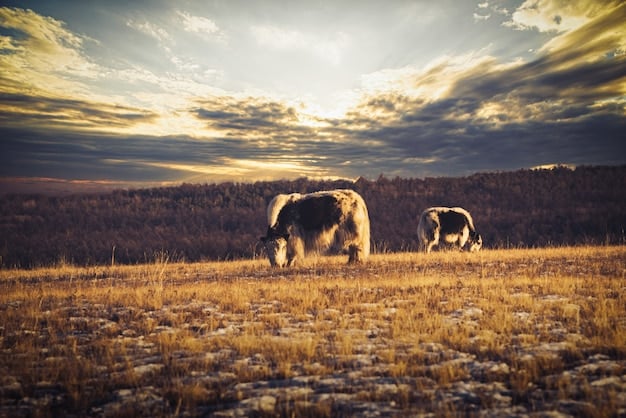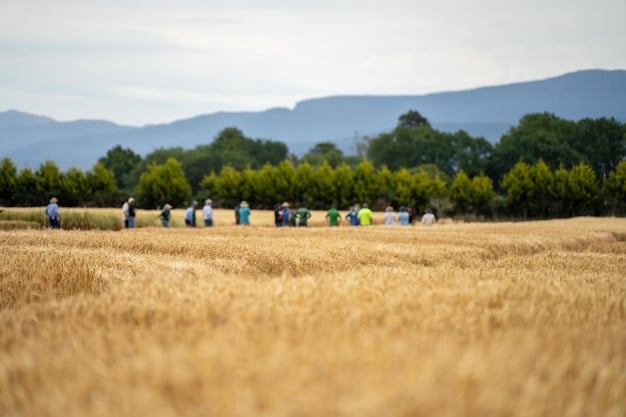Government Support for Farmers: A Comprehensive Guide

Government Support for Farmers: Understanding Subsidies, Loans, and Conservation Programs provides crucial financial and technical assistance to help farmers manage risks, improve sustainability, and ensure a stable food supply in the United States.
Navigating the landscape of Government Support for Farmers: Understanding Subsidies, Loans, and Conservation Programs can be complex, yet understanding these resources is vital for the success and sustainability of agricultural operations in the U.S.
Understanding Government Subsidies for Farmers
Government subsidies play a significant role in supporting the agricultural sector. These programs aim to stabilize farm incomes, manage supply, and ensure food security by providing financial assistance to farmers facing market fluctuations and other challenges. Understanding how these subsidies work and who is eligible is crucial for farmers looking to maximize their benefits and for policymakers seeking to refine these support systems.
Types of Subsidies Available
The U.S. government offers a variety of subsidies designed to address different needs and challenges within the agricultural sector. These can be broadly categorized into direct payments, counter-cyclical payments, and conservation incentives.
- Direct Payments: These are fixed payments made to farmers regardless of current market prices or production levels. They were designed to provide a predictable income stream but have been phased out in favor of other subsidy types.
- Counter-Cyclical Payments: These payments are triggered when market prices fall below a certain level. They aim to protect farmers from significant income losses due to price volatility.
- Conservation Incentives: These programs provide financial assistance to farmers who implement conservation practices that benefit the environment.

Eligibility Criteria for Subsidies
Eligibility for government subsidies varies depending on the specific program. Generally, farmers must meet certain requirements related to land use, crop production, and conservation practices. Some programs may also have income or production limits.
Farmers need to register with the Farm Service Agency (FSA) and provide documentation demonstrating their eligibility. This may include farm records, income statements, and conservation plans. Meeting these criteria is essential for accessing the financial support these programs offer.
In conclusion, government subsidies are a critical component of the agricultural safety net, providing financial stability and encouraging sustainable farming practices. To fully leverage these opportunities, farmers need to understand the different types of subsidies, eligibility requirements, and application processes.
Farm Loans: Accessing Credit and Financial Assistance
Access to credit is essential for farmers to invest in their operations, manage cash flow, and overcome financial challenges. Farm loans, offered by both government and private lenders, provide farmers with the capital they need to start, expand, or maintain their businesses. Understanding the different types of farm loans and how to access them is critical for ensuring financial stability and growth.
Government Loan Programs
The U.S. Department of Agriculture (USDA) offers a range of loan programs specifically designed to support farmers. These programs provide various types of financial assistance, including direct loans, guaranteed loans, and emergency loans.
Direct loans are provided directly by the USDA to farmers who may not qualify for commercial loans. Guaranteed loans, on the other hand, involve the USDA guaranteeing a loan made by a private lender, reducing the lender’s risk and making it more likely for farmers to obtain credit. Emergency loans are available to farmers who have suffered losses due to natural disasters.
Private Loan Options for Farmers
In addition to government loans, farmers can also access credit through private lenders, such as banks, credit unions, and farm credit institutions. These lenders offer a variety of loan products tailored to the needs of agricultural businesses.
- Operating Loans: These loans are used to cover day-to-day expenses, such as seed, fertilizer, and labor.
- Equipment Loans: These loans are used to finance the purchase of machinery and equipment.
- Real Estate Loans: These loans are used to purchase farmland or construct farm buildings.
When seeking private loans, farmers should shop around to compare interest rates, fees, and loan terms. Building a strong relationship with a lender and presenting a solid business plan can increase the chances of loan approval.
In summary, farm loans are an essential tool for farmers seeking to finance their operations and manage their finances. Whether through government programs or private lenders, access to credit can help farmers invest in their businesses and overcome financial challenges.
Conservation Programs: Promoting Sustainable Farming
Conservation programs play a vital role in promoting sustainable farming practices and protecting natural resources. These programs offer financial and technical assistance to farmers who implement conservation measures that improve soil health, water quality, and wildlife habitat. Understanding the benefits of these programs is essential for farmers looking to enhance the sustainability of their operations and contribute to environmental stewardship.
The Environmental Quality Incentives Program (EQIP)
The Environmental Quality Incentives Program (EQIP) is one of the most widely used conservation programs. It provides financial and technical assistance to farmers who implement conservation practices on their land. These practices can include cover cropping, no-till farming, and nutrient management.
EQIP helps farmers address natural resource concerns and improve the health of their land. By implementing conservation practices, farmers can reduce soil erosion, improve water quality, and enhance wildlife habitat.
The Conservation Stewardship Program (CSP)
The Conservation Stewardship Program (CSP) rewards farmers who are already implementing conservation practices and encourages them to adopt additional measures to improve their environmental performance. CSP provides payments to farmers who actively manage, maintain, and enhance existing conservation efforts.

CSP focuses on whole-farm conservation, encouraging farmers to address multiple resource concerns across their entire operation. This approach promotes a more holistic and sustainable approach to farming.
In conclusion, conservation programs are a valuable resource for farmers looking to promote sustainable farming practices and protect natural resources. By participating in programs like EQIP and CSP, farmers can improve the health of their land, enhance their environmental stewardship, and contribute to a more sustainable agricultural sector.
Navigating the Application Process for Government Support
Applying for government support programs can seem daunting, but understanding the process and preparing the necessary documentation can make it more manageable. This section provides a step-by-step guide to navigating the application process and maximizing your chances of success.
Step 1: Researching Available Programs
The first step in the application process is to research the available programs and identify those that best meet your needs. The USDA’s website is a valuable resource for finding information on various subsidy, loan, and conservation programs.
Take the time to review the eligibility criteria, application deadlines, and program requirements for each program you are interested in. This will help you determine which programs are the best fit for your operation.
Step 2: Gathering Required Documentation
Once you have identified the programs you want to apply for, the next step is to gather the required documentation. This may include farm records, income statements, conservation plans, and other supporting documents.
- Farm Records: These records provide information on your crop production, land use, and farming practices.
- Income Statements: These statements provide information on your farm’s financial performance.
- Conservation Plans: These plans outline the conservation practices you are implementing on your land.
Step 3: Submitting Your Application
After gathering the required documentation, you can submit your application to the appropriate agency. In many cases, applications can be submitted online or in person at your local Farm Service Agency (FSA) office.
Be sure to submit your application by the deadline and follow all instructions carefully. Incomplete or late applications may be rejected.
In summary, navigating the application process for government support programs requires careful planning and preparation. By researching available programs, gathering the required documentation, and submitting your application on time, you can increase your chances of receiving the support you need to succeed.
The Impact of Government Support on the Agricultural Economy
Government support for farmers, through subsidies, loans, and conservation programs, has a significant impact on the agricultural economy. These programs influence farm incomes, production levels, and environmental sustainability.
Stabilizing Farm Incomes
One of the primary goals of government support programs is to stabilize farm incomes. Subsidies and counter-cyclical payments can help farmers weather periods of low prices and market volatility, providing a safety net that ensures they can continue to operate.
By providing a stable income stream, government support programs reduce the risk of farm bankruptcies and help maintain a viable agricultural sector.
Promoting Sustainable Practices
Conservation programs encourage farmers to adopt sustainable farming practices that benefit the environment. These practices can improve soil health, water quality, and wildlife habitat, contributing to a more sustainable agricultural sector.
By promoting sustainable practices, government support programs help ensure that agriculture can continue to thrive while protecting natural resources for future generations.
Ensuring Food Security
Government support programs also play a role in ensuring food security. By supporting domestic agricultural production, these programs help maintain a stable supply of food for consumers.
When farmers have the resources they need to produce food, it helps guarantee a reliable food supply for the nation.
In conclusion, government support for farmers has a wide-ranging impact on the agricultural economy. These programs stabilize farm incomes, promote sustainable practices, and ensure food security, contributing to a healthy and resilient agricultural sector.
Future Trends in Government Support for Farmers
As the agricultural sector continues to evolve, so too will the government support programs that serve it. Several trends are shaping the future of these programs, including a greater focus on conservation, risk management, and local food systems.
Increased Focus on Conservation
There is a growing recognition of the importance of sustainable farming practices and the role they play in protecting natural resources. As a result, future government support programs are likely to place a greater emphasis on conservation.
- Climate Change Mitigation: Programs may incentivize practices that reduce greenhouse gas emissions and sequester carbon in the soil.
- Water Quality Protection: Programs may target areas with impaired water quality and provide financial assistance for practices that reduce nutrient runoff and pollution.
Enhanced Risk Management Tools
Farmers face a variety of risks, including weather events, market volatility, and pest outbreaks. Future government support programs are likely to focus on providing farmers with enhanced risk management tools to help them mitigate these risks.
This may include expanding crop insurance programs, developing new risk management strategies, and providing farmers with education and training on risk management techniques.
Support for Local Food Systems
There is growing interest in local food systems and the benefits they provide, including increased access to fresh, healthy food, support for local economies, and reduced environmental impact.
Future government support programs may provide assistance to farmers who sell directly to consumers, participate in farmers markets, or supply local food businesses.
In summary, the future of government support for farmers is likely to be shaped by a greater focus on conservation, risk management, and local food systems. These trends reflect a growing recognition of the importance of sustainable agriculture, farmer resilience, and local food security.
| Key Point | Brief Description |
|---|---|
| 💰 Subsidies | Financial aid to stabilize income. |
| 🚜 Farm Loans | Credit for operations and growth. |
| 🌱 Conservation | Programs for sustainable practices. |
| 🛡️ Risk Management | Tools to mitigate financial risks. |
Frequently Asked Questions
Various subsidies exist, including direct payments (fixed), counter-cyclical (price-triggered), and conservation incentives for eco-friendly practices. Eligibility varies by program and farm specifics.
USDA offers direct loans, guaranteed loans (via private lenders), and emergency loans for disaster recovery. Eligibility requires meeting USDA criteria and can be applied via the Farm Service Agency.
EQIP offers financial and technical aid for implementing conservation practices like cover cropping and no-till farming. This helps improve soil health and water quality on farmland.
It stabilizes farm income during market volatility, promotes sustainable farming, enhances food security by supporting domestic production, and encourages responsible land management practices.
Expect increased focus on conservation, enhanced risk management tools (like improved crop insurance), and greater support for local food systems and direct-to-consumer sales channels.
Conclusion
In conclusion, understanding and utilizing government support programs is essential for farmers to thrive in today’s agricultural landscape. By leveraging subsidies, loans, and conservation incentives, farmers can enhance their financial stability, promote sustainable practices, and contribute to a resilient agricultural sector.





